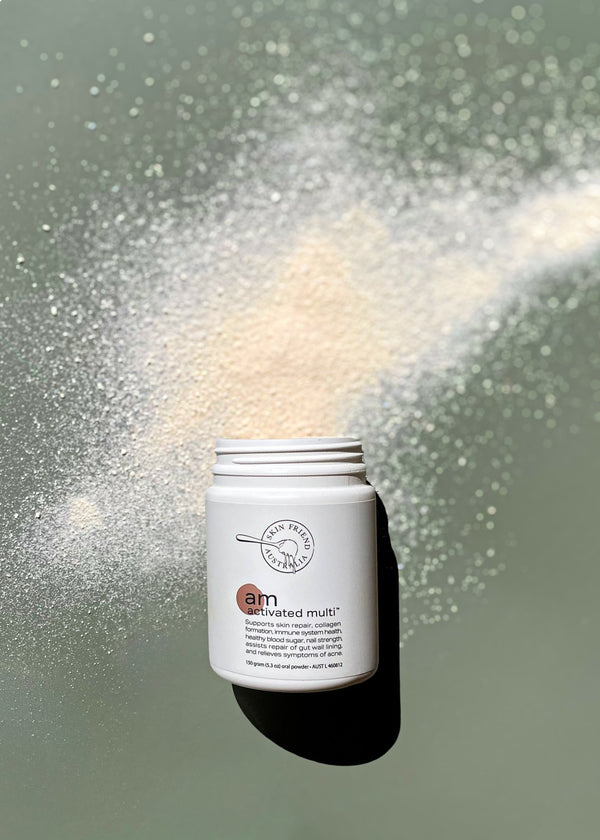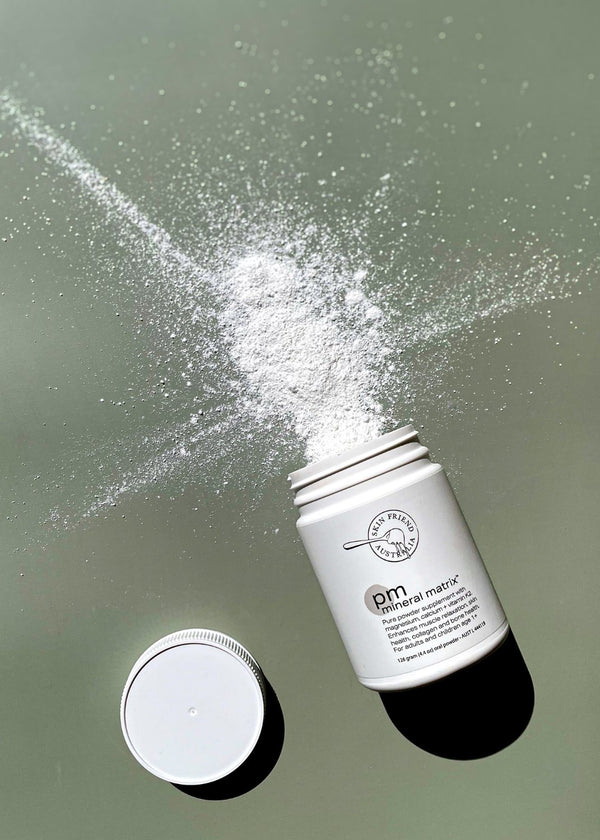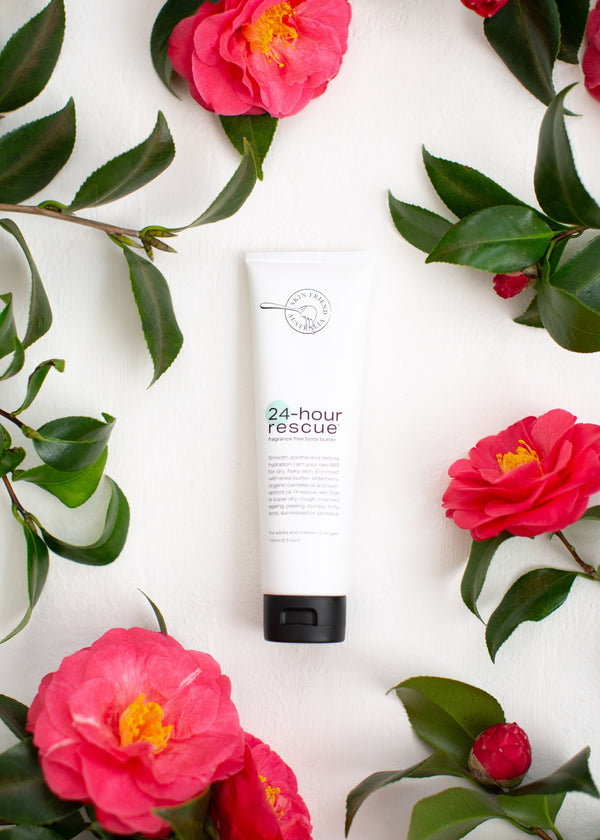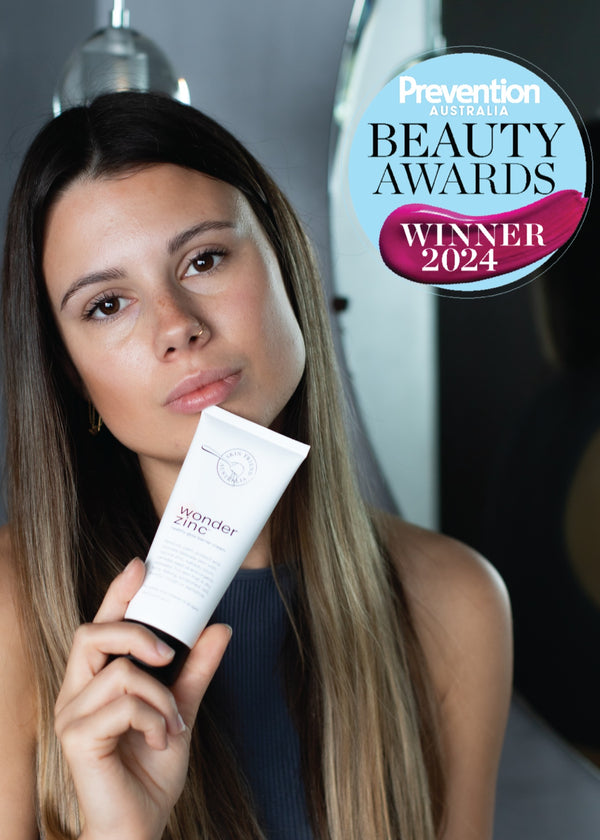
Eczema Around Skin Folds (Eczema and Intertrigo)
If you struggle with eczema – also known as atopic dermatitis – you’ll know that it’s uncomfortable, itchy and can be difficult to manage. But some areas can be even more frustrating than others. Fortunately there is plenty you can do to manage and prevent this condition (more on this shortly).
Eczema intertrigo refers to when eczema rashes develop on sensitive areas and skinfolds, like armpit and groin eczema, making flare-ups more likely and uncomfortable.

Finding Relief from Eczema and Intertrigo
Managing eczema in those sensitive areas means paying attention to both your skincare regime and diet – to restore the skin barrier and reduce irritation, while allowing the skin to breathe (this means avoiding ointments!).
At Skin Friend, our approach is simple: gentle, science-backed care that supports the skin barrier without harsh additives, fragrances or steroids.
Eczema and Intertrigo: Why Does it Happen?
Like any kind of atopic dermatitis, both eczema and intertrigo occur when the skin barrier is weakened, allowing moisture loss and irritation. This can lead to redness, itching, tenderness and sometimes visible cracking or flaking.
Because skin folds are naturally more humid, they’re also more susceptible to secondary irritation from sweat, skincare products and clothing. Without the proper care, these eczema and intertrigo flare-ups can become recurrent and difficult to manage. So treat flares immediately, as a delay may lead to an infection that can worsen eczema.
Common Causes and Triggers
Eczema in the skin folds can be triggered by a variety of external and internal factors, such as:
- Friction from synthetic clothing, movement or skin-on-skin contact
- Salty sweat and trapped moisture in warm, enclosed areas, leading to skin infections linked to eczema, such as staph which loves salt (so avoid salt baths)
- All soaps are harsh on skin as they have a high pH, and this causes the protective microbiome to dislodge, leaving your skin vulnerable to infections like staph
- Fragranced body products (avoid ingredients like fragrance or parfum) as it’s a common skin irritant
- Synthetic or tight fabrics that don’t allow airflow – polyester and wool can irritate skin and cause eczema to become itchier
- Stress and poor sleep
- Nutritional deficiencies
- Salicylate or histamine intolerance
- Intolerance and allergies to common foods, especially dairy, hen’s egg, wheat, peanut and soy, according to research

Caring for Eczema and Intertrigo
Managing armpit eczema, groin eczema or other intertrigo-prone areas starts with reducing irritation, maintaining hydration and reinforcing the skin barrier.
- Gentle Cleansing: Wash with lukewarm water and avoid all cleansers for now, to avoid stripping natural oils.
- Daily Moisturising: Apply a natural eczema cream that’s lightweight yet barrier-protective. Ingredients like zinc oxide and provitamin B5 (dexpanthenol) can help soothe skin and relieve mild eczema and dermatitis.
- Reduce Friction: Choose loose-fitting clothing from breathable natural fibres like 100% cotton or bamboo to allow airflow and minimise rubbing.
- Keep Skin Dry but Hydrated: Pat skin dry after bathing and avoid leaving sweat or moisture trapped in folds to help with eczema and intertrigo.
- Internal Support: Feed your skin from within with targeted nutrients like vitamin C, molybdenum, glycine and methylated B vitamins to maintain healthy skin and zinc gluconate to help repair the gut wall lining.
Recommended Skin Friend Products
Caring for eczema-prone skin – especially in sensitive areas – works best when you combine the right topical care with targeted internal support.
At Skin Friend, every product is crafted with care and backed by science to be gentle, effective and free from nasties, so you can feel confident about what you’re putting on your skin and into your body.
Topical Treatments:
Our creams are carefully pH-optimised at 4.6 – the same natural acidity as healthy skin – to help maintain your skin’s microbiome and protect its barrier function. This means they work in harmony with your skin, not against it.
- Wonder Zinc: Our award-winning zinc oxide cream forms a light, breathable layer to help shield sensitive skin from everyday irritants, while supporting a calm, comfortable feel.
- Eczema Friend: A soothing, steroid-free, pH-friendly eczema cream enriched with provitamin B5 to soothe skin and relieve mild eczema and dermatitis.
- 24-Hour Rescue: Deep, lasting moisture that keeps even the most delicate areas feeling soft, smooth and protected all day long. Use this once your skin clears up to maintain your results and protect from future flares.
Nourishing Skin From Within:
Healthy skin starts on the inside. That’s why Skin Friend offers a simple two-part supplement ritual to provide targeted support around the clock for dry, red skin including eczema and intertrigo.
Skin Friend AM: Morning blend of zinc, vitamin C, and activated (methylated) B vitamins to support energy levels, skin health and collagen formation.
Skin Friend PM: Your afternoon ”cup of calm” with magnesium and calcium to support healthy sleeping patterns, skin health and muscle relaxation.
Our Hero Ingredients
- Zinc Oxide – Forms a gentle protective layer to shield against irritants.
- Niacinamide (Vitamin B3) – Supports skin health and helps reduce the appearance of redness.
- Vitamin C – Supports collagen formation.
- Magnesium and Calcium – to support healthy sleeping patterns and muscle relaxation, because optimal beauty sleep is essential for skin health.
Choose Skin Friend for Sensitive Skin Care
At Skin Friend, we believe calm, healthy skin should be your everyday normal.
Founded by award-winning nutritionist Karen Fischer, our products combine 20+ years of clinical experience with clean, effective formulas designed to protect and work in harmony with your skin.
Whether you’re caring for armpit eczema, groin eczema or any other sensitive areas, our prevention-focused approach helps strengthen skin resilience over time – so you can feel confident, comfortable and supported every day.
Explore Eczema by Body Area
- Eczema Around the Eyes and Eyelids
- Eczema on Hands and Fingers
- Eczema on Elbows and Knees
- Eczema on Feet and Ankles
-
Eczema on the Face and Scalp
Click for references
References:
- Campbell JL, Coyer FM. (2022). Skin care for the protection and treatment of incontinence-associated dermatitis (IAD) to minimise susceptibility to pressure injury (PI) development. Wound Practice and Research, 40(4), 160-167.
- Chovatiya R. (2023). Atopic dermatitis (eczema). JAMA, 329(3), 268.
- Christensen MO, et al. Prevalence of and association between atopic dermatitis and food sensitivity, food allergy and challenge-proven food allergy: A systematic review and meta-analysis. J Eur Acad Dermatol Venereol. 2023 May;37(5):984-1003. doi: 10.1111/jdv.18919.
- Elias, PM., et al. (2002). Modulations in epidermal calcium regulate the expression of differentiation-specific markers. Journal of Investigative Dermatology, 119(5), pp.1128–1136.
- Fischer, K., et al. (2025). Prevalence of Intolerance to Amines and Salicylates in Individuals with Atopic Dermatitis: A Systematic Review and Meta-Analysis. Nutrients, 17, 1628.
- Fivenson DP. The mechanisms of action of nicotinamide and zinc in inflammatory skin disease. Cutis. 2006 Jan;77(1 Suppl):5-10. PMID: 16871773.
- Lambers H, et al. Natural skin surface pH is on average below 5, which is beneficial for its resident flora. Int J Cosmet Sci. 2006 Oct;28(5):359-70. doi: 10.1111/j.1467-2494.2006.00344.x. PMID: 18489300.
- Sharma V, et al. Zinc in dermatology: a review. Dermatol Res Pract. 2014;2014:709152. doi:10.1155/2014/709152.
- Zhu Z, et al. Assessment of the effectiveness of vitamin supplement in treating eczema: a systematic review and meta-analysis. Evid Based Complement Alternat Med. 2019 Oct 31;2019:6956034. doi: 10.1155/2019/6956034.





